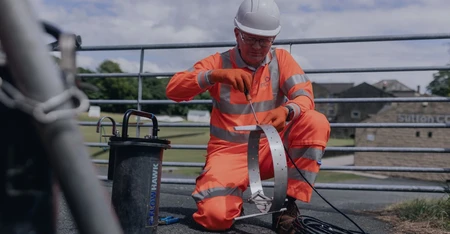Need some advice?
Leave your details and we will get in touch.
I want to be contacted by an expert1 /
Ensuring Safety, Reliability & Compliance
The railway network operates in a complex and demanding environment where unknown materials and substances can pose serious risks to safety, operations, and infrastructure integrity. Whether it’s an unexpected residue present on rolling stock, an unknown deposit affecting track signalling performance, or a contamination issue within maintenance depots, rapid and accurate identification is crucial.
SOCOTEC has over 50 years of practical experience in the industry, specialising in the sampling, analysis and subsequent identification of unknown substances found at various rail sites and depots. With a scientific evidence-based approach, our Chemical Analysis services help rail operators, infrastructure managers and maintenance teams safely and efficiently manage the presence of unknown materials onsite, ensuring minimal disruption to day-to-day operations.
UNDERSTANDING UNKNOWN MATERIALS IN THE RAIL SECTOR
Unknown materials and substances can originate from various sources in the rail industry, including:
The presence of unknown materials and substances can lead to operational inefficiencies, safety hazards, or regulatory non-compliance. Identifying and understanding these substances is essential for effective management and risk mitigation.
METHODS OF IDENTIFICATION
Our modern scientific techniques play a crucial role in identifying unknown materials in the rail industry. Some of the most effective methods include:
These techniques provide a thorough understanding of unknown materials, allowing for informed decision-making regarding maintenance, repairs, and operational adjustments.
IMPACT ON RAIL OPERATIONS
Unknown materials can significantly impact railway operations in various ways:
INDUSTRY REGULATIONS & BEST PRACTICES
Ensuring compliance with industry regulations is crucial in managing unknown materials. Best practices include:
Understanding the composition and impact of unknown materials allows the rail industry to maintain safety, efficiency and regulatory compliance, ultimately contributing to a more reliable transport network.
WHY CHOOSE US?
SOCOTEC understands that every rail challenge is unique, which is why we take a client-focused approach to unknown material identification. Our experienced Site Teams are well versed in sampling unknown materials and substances within the railway environment whilst our Advanced Chemistry and Research laboratories are fully equipped to carry out the wide range of analysis frequently needed to identify such materials. Using a diverse range of advanced analytical techniques, we ensure accurate and reliable results.
Once the analysis has been completed, experienced Technical specialists are then able to interpret the results calling on many years experience of working within the rail industry. Once our experts have identified the unknown material, we provide a comprehensive, interpretive report detailing all insights and findings. Our reports are designed to be actionable, helping rail operators and maintenance teams make informed decisions quickly to maintain safety and efficiency.









